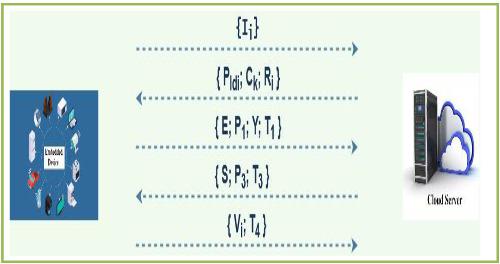当前位置:
X-MOL 学术
›
Int. J. Commun. Syst.
›
论文详情
Our official English website, www.x-mol.net, welcomes your feedback! (Note: you will need to create a separate account there.)
An enhanced authentication scheme for Internet of Things and cloud based on elliptic curve cryptography
International Journal of Communication Systems ( IF 2.1 ) Pub Date : 2021-04-26 , DOI: 10.1002/dac.4834 Pallavi Bhuarya 1 , Preeti Chandrakar 2 , Rifaqat Ali 3 , Aakanksha Sharaff 2
International Journal of Communication Systems ( IF 2.1 ) Pub Date : 2021-04-26 , DOI: 10.1002/dac.4834 Pallavi Bhuarya 1 , Preeti Chandrakar 2 , Rifaqat Ali 3 , Aakanksha Sharaff 2
Affiliation

|
Authentication plays a fundamental role in achieving security over unreliable channels. Authentication is a technique that lets an entity verify the identity of other communicating entities. There are a plethora of authentication schemes available in recent times. A short time ago, Kumari et al. offered an authentication protocol using elliptic curve cryptography (ECC) for Internet of Things (IoT) and professed that their design defends various security attacks. We examined Kumari et al.'s scheme and detected some loopholes like (1) inefficient login phase, (2) inefficient authentication phase, (3) known session-specific temporary information attack, (4) denial-of-service (DoS) attack, and (5) lack of password changing phase. To eradicate all these flaws, we present an enhanced authentication protocol utilizing ECC for deployment in the field of IoT using cloud servers. This protocol uses hypertext transfer protocol (HTTP) cookies to authenticate clients. The developed protocol provides various security features and able to counter various security attacks. The security analysis validates that the extended scheme is potent. We simulate our protocol in Automated Validation of Internet Security Protocols and Applications (AVISPA) tool that evaluates the safety of the scheme in the presence of an adversary. We compare the proposed scheme with some similar schemes in respect of computation cost, estimated time, storage cost, communication cost, and security features.
中文翻译:

一种基于椭圆曲线密码学的物联网和云增强认证方案
身份验证在实现不可靠通道的安全性方面发挥着重要作用。身份验证是一种让实体验证其他通信实体身份的技术。最近有大量可用的身份验证方案。不久前,Kumari 等人。为物联网 (IoT) 提供了使用椭圆曲线加密 (ECC) 的身份验证协议,并声称他们的设计可以防御各种安全攻击。我们检查了 Kumari 等人的方案并发现了一些漏洞,例如 (1) 登录阶段效率低下,(2) 身份验证阶段效率低下,(3) 已知会话特定的临时信息攻击,(4) 拒绝服务 (DoS)攻击,以及 (5) 缺少密码更改阶段。为了消除所有这些缺陷,我们提出了一种利用 ECC 的增强型身份验证协议,用于使用云服务器在物联网领域进行部署。此协议使用超文本传输协议 (HTTP) cookie 来验证客户端。开发的协议提供了各种安全特性,能够抵御各种安全攻击。安全分析验证扩展方案是有效的。我们在 Internet 安全协议和应用程序的自动验证 (AVISPA) 工具中模拟我们的协议,该工具在对手存在的情况下评估该方案的安全性。我们在计算成本、估计时间、存储成本、通信成本和安全特性方面将所提出的方案与一些类似的方案进行了比较。开发的协议提供了各种安全特性,能够抵御各种安全攻击。安全分析验证扩展方案是有效的。我们在 Internet 安全协议和应用程序的自动验证 (AVISPA) 工具中模拟我们的协议,该工具在对手存在的情况下评估该方案的安全性。我们在计算成本、估计时间、存储成本、通信成本和安全特性方面将所提出的方案与一些类似的方案进行了比较。开发的协议提供了各种安全特性,能够抵御各种安全攻击。安全分析验证扩展方案是有效的。我们在 Internet 安全协议和应用程序的自动验证 (AVISPA) 工具中模拟我们的协议,该工具在对手存在的情况下评估该方案的安全性。我们在计算成本、估计时间、存储成本、通信成本和安全特性方面将所提出的方案与一些类似的方案进行了比较。
更新日期:2021-06-03
中文翻译:

一种基于椭圆曲线密码学的物联网和云增强认证方案
身份验证在实现不可靠通道的安全性方面发挥着重要作用。身份验证是一种让实体验证其他通信实体身份的技术。最近有大量可用的身份验证方案。不久前,Kumari 等人。为物联网 (IoT) 提供了使用椭圆曲线加密 (ECC) 的身份验证协议,并声称他们的设计可以防御各种安全攻击。我们检查了 Kumari 等人的方案并发现了一些漏洞,例如 (1) 登录阶段效率低下,(2) 身份验证阶段效率低下,(3) 已知会话特定的临时信息攻击,(4) 拒绝服务 (DoS)攻击,以及 (5) 缺少密码更改阶段。为了消除所有这些缺陷,我们提出了一种利用 ECC 的增强型身份验证协议,用于使用云服务器在物联网领域进行部署。此协议使用超文本传输协议 (HTTP) cookie 来验证客户端。开发的协议提供了各种安全特性,能够抵御各种安全攻击。安全分析验证扩展方案是有效的。我们在 Internet 安全协议和应用程序的自动验证 (AVISPA) 工具中模拟我们的协议,该工具在对手存在的情况下评估该方案的安全性。我们在计算成本、估计时间、存储成本、通信成本和安全特性方面将所提出的方案与一些类似的方案进行了比较。开发的协议提供了各种安全特性,能够抵御各种安全攻击。安全分析验证扩展方案是有效的。我们在 Internet 安全协议和应用程序的自动验证 (AVISPA) 工具中模拟我们的协议,该工具在对手存在的情况下评估该方案的安全性。我们在计算成本、估计时间、存储成本、通信成本和安全特性方面将所提出的方案与一些类似的方案进行了比较。开发的协议提供了各种安全特性,能够抵御各种安全攻击。安全分析验证扩展方案是有效的。我们在 Internet 安全协议和应用程序的自动验证 (AVISPA) 工具中模拟我们的协议,该工具在对手存在的情况下评估该方案的安全性。我们在计算成本、估计时间、存储成本、通信成本和安全特性方面将所提出的方案与一些类似的方案进行了比较。


























 京公网安备 11010802027423号
京公网安备 11010802027423号